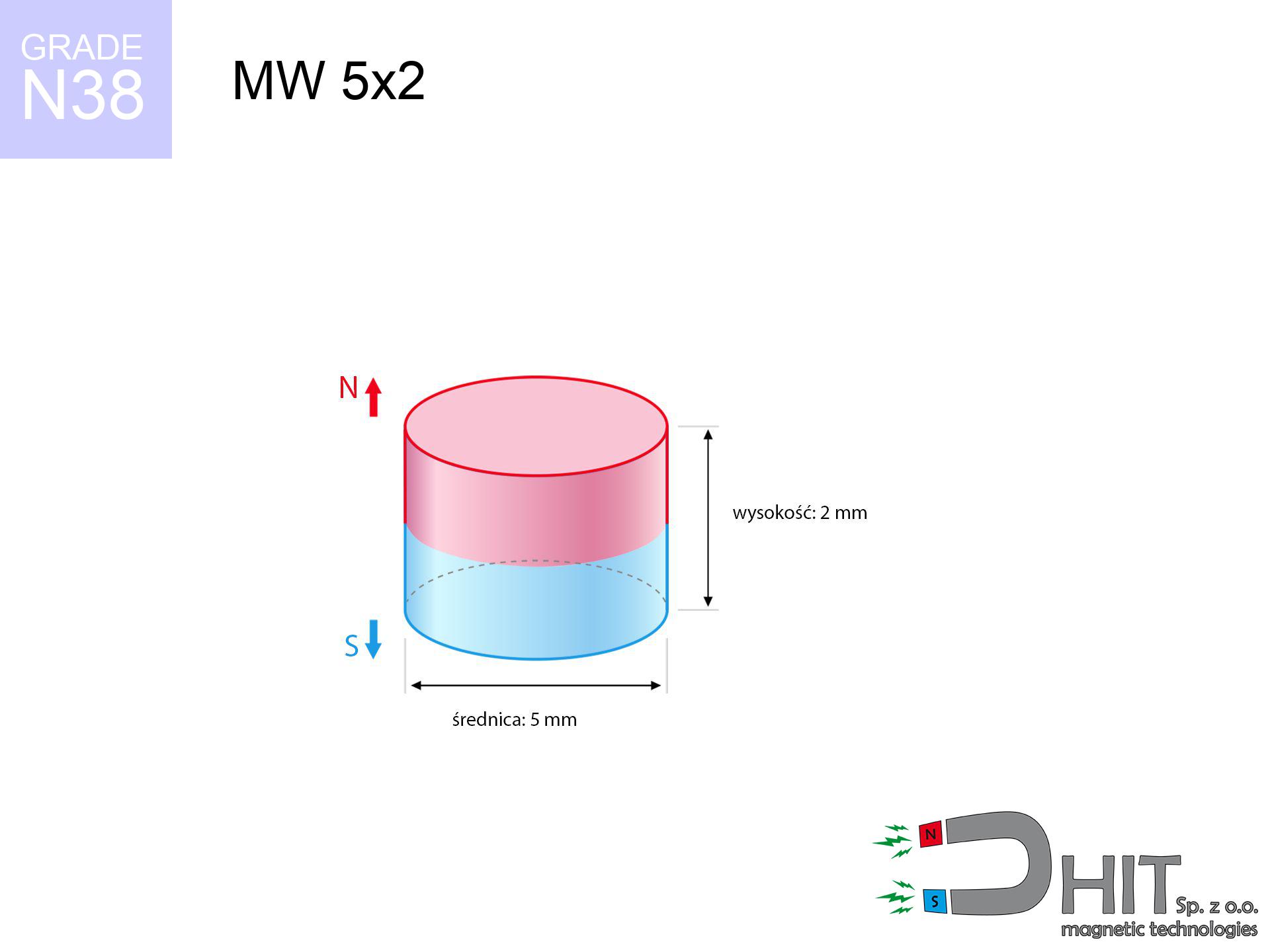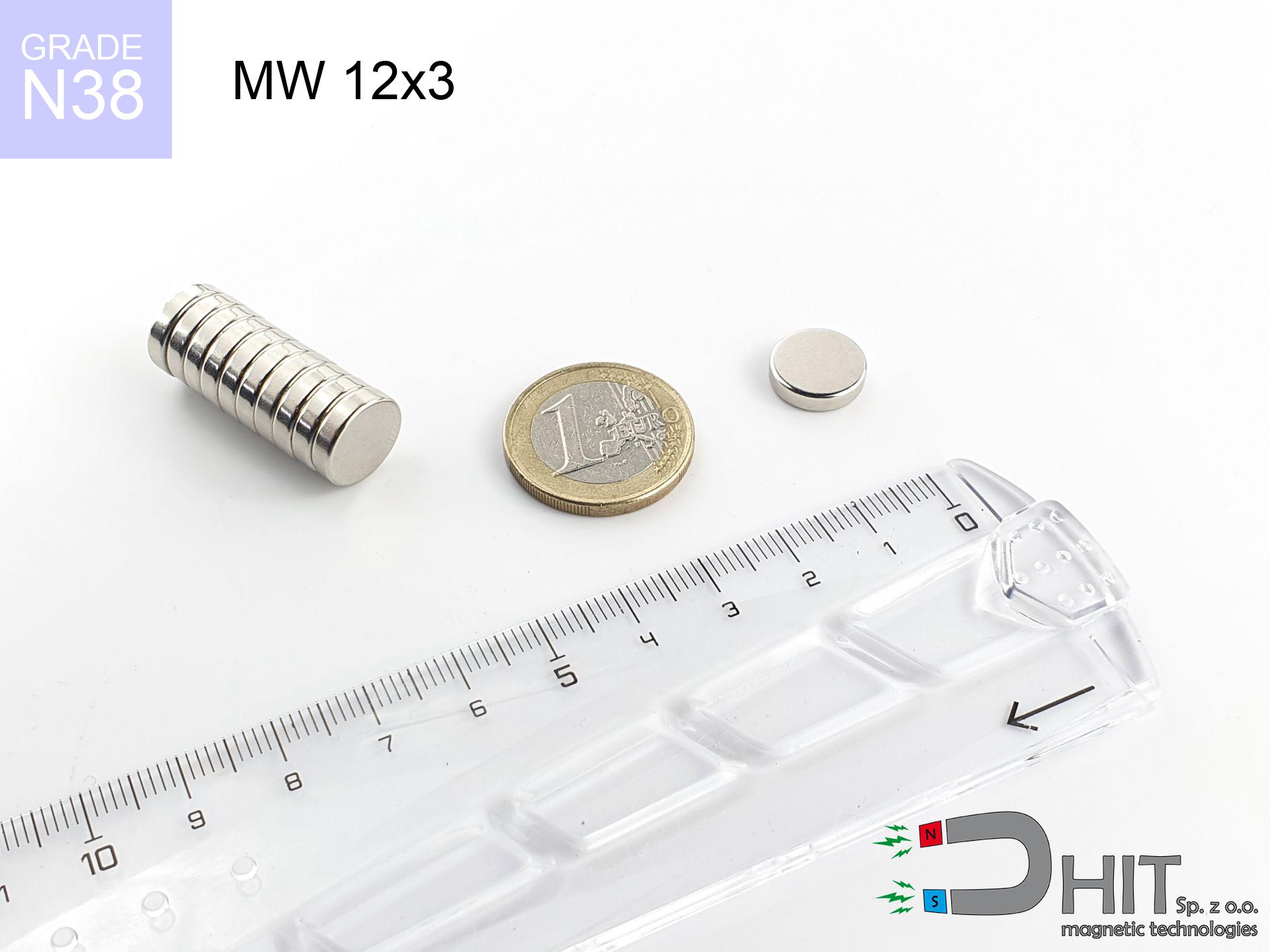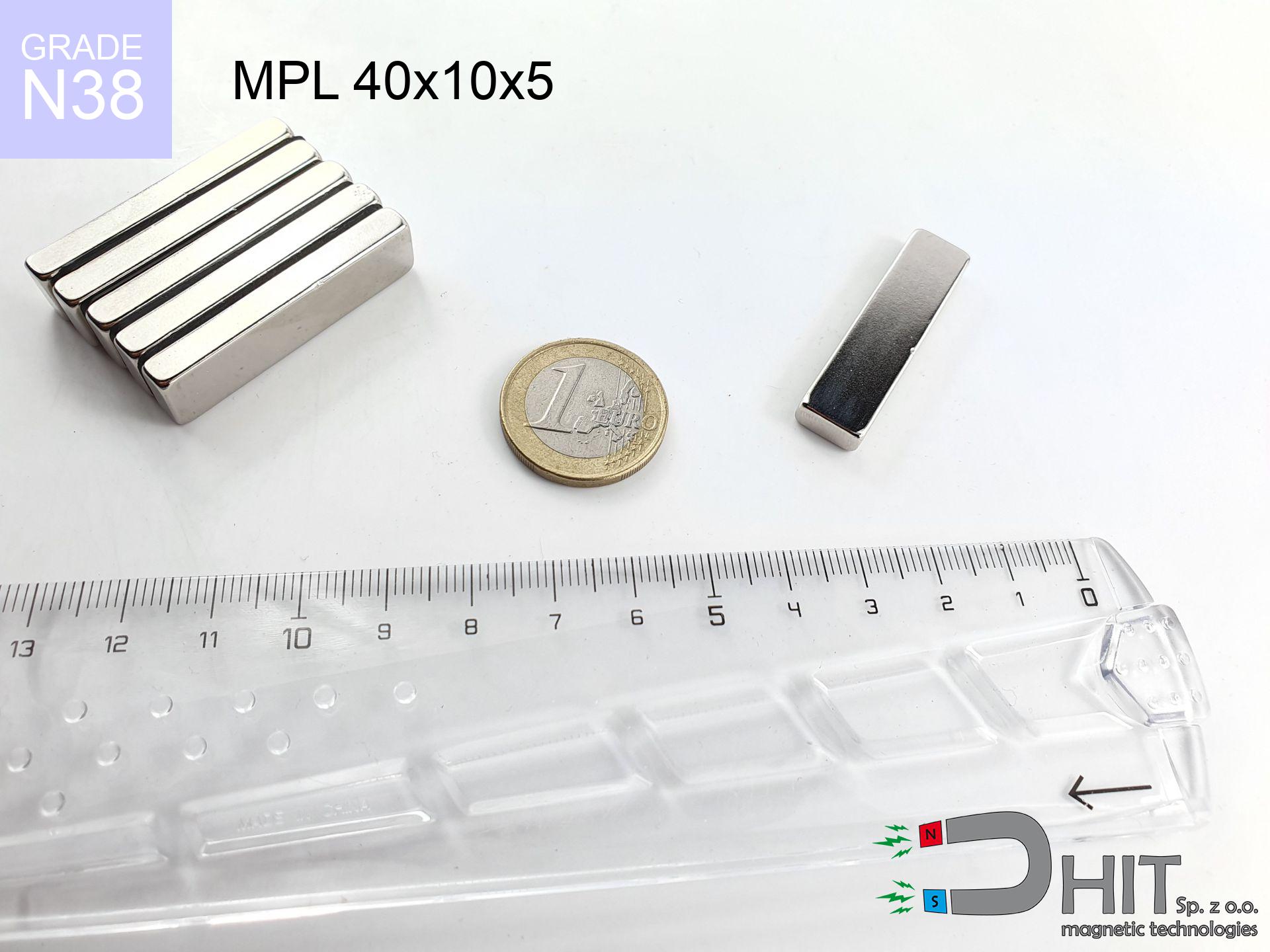MW 5x2 / N38 - cylindrical magnet
cylindrical magnet
Catalog no 010085
GTIN/EAN: 5906301810841
Diameter Ø
5 mm [±0,1 mm]
Height
2 mm [±0,1 mm]
Weight
0.29 g
Magnetization Direction
↑ axial
Load capacity
0.70 kg / 6.83 N
Magnetic Induction
386.50 mT / 3865 Gs
Coating
[NiCuNi] Nickel
0.1845 ZŁ with VAT / pcs + price for transport
0.1500 ZŁ net + 23% VAT / pcs
bulk discounts:
Need more?Hunting for a discount?
Call us now
+48 22 499 98 98
otherwise contact us through
our online form
the contact section.
Lifting power along with form of magnetic components can be calculated using our
online calculation tool.
Same-day shipping for orders placed before 14:00.
MW 5x2 / N38 - cylindrical magnet
Specification / characteristics MW 5x2 / N38 - cylindrical magnet
| properties | values |
|---|---|
| Cat. no. | 010085 |
| GTIN/EAN | 5906301810841 |
| Production/Distribution | Dhit sp. z o.o. |
| Country of origin | Poland / China / Germany |
| Customs code | 85059029 |
| Diameter Ø | 5 mm [±0,1 mm] |
| Height | 2 mm [±0,1 mm] |
| Weight | 0.29 g |
| Magnetization Direction | ↑ axial |
| Load capacity ~ ? | 0.70 kg / 6.83 N |
| Magnetic Induction ~ ? | 386.50 mT / 3865 Gs |
| Coating | [NiCuNi] Nickel |
| Manufacturing Tolerance | ±0.1 mm |
Magnetic properties of material N38
| properties | values | units |
|---|---|---|
| remenance Br [min. - max.] ? | 12.2-12.6 | kGs |
| remenance Br [min. - max.] ? | 1220-1260 | mT |
| coercivity bHc ? | 10.8-11.5 | kOe |
| coercivity bHc ? | 860-915 | kA/m |
| actual internal force iHc | ≥ 12 | kOe |
| actual internal force iHc | ≥ 955 | kA/m |
| energy density [min. - max.] ? | 36-38 | BH max MGOe |
| energy density [min. - max.] ? | 287-303 | BH max KJ/m |
| max. temperature ? | ≤ 80 | °C |
Physical properties of sintered neodymium magnets Nd2Fe14B at 20°C
| properties | values | units |
|---|---|---|
| Vickers hardness | ≥550 | Hv |
| Density | ≥7.4 | g/cm3 |
| Curie Temperature TC | 312 - 380 | °C |
| Curie Temperature TF | 593 - 716 | °F |
| Specific resistance | 150 | μΩ⋅cm |
| Bending strength | 250 | MPa |
| Compressive strength | 1000~1100 | MPa |
| Thermal expansion parallel (∥) to orientation (M) | (3-4) x 10-6 | °C-1 |
| Thermal expansion perpendicular (⊥) to orientation (M) | -(1-3) x 10-6 | °C-1 |
| Young's modulus | 1.7 x 104 | kg/mm² |
Technical simulation of the magnet - technical parameters
These data represent the direct effect of a engineering analysis. Values are based on models for the material Nd2Fe14B. Actual parameters might slightly differ from theoretical values. Use these calculations as a reference point when designing systems.
MW 5x2 / N38
| Distance (mm) | Induction (Gauss) / mT | Pull Force (kg) | Risk Status |
|---|---|---|---|
| 0 mm |
3860 Gs
386.0 mT
|
0.70 kg / 700.0 g
6.9 N
|
safe |
| 1 mm |
2460 Gs
246.0 mT
|
0.28 kg / 284.4 g
2.8 N
|
safe |
| 2 mm |
1384 Gs
138.4 mT
|
0.09 kg / 90.0 g
0.9 N
|
safe |
| 3 mm |
782 Gs
78.2 mT
|
0.03 kg / 28.8 g
0.3 N
|
safe |
| 5 mm |
293 Gs
29.3 mT
|
0.00 kg / 4.0 g
0.0 N
|
safe |
| 10 mm |
55 Gs
5.5 mT
|
0.00 kg / 0.1 g
0.0 N
|
safe |
| 15 mm |
18 Gs
1.8 mT
|
0.00 kg / 0.0 g
0.0 N
|
safe |
| 20 mm |
8 Gs
0.8 mT
|
0.00 kg / 0.0 g
0.0 N
|
safe |
| 30 mm |
3 Gs
0.3 mT
|
0.00 kg / 0.0 g
0.0 N
|
safe |
| 50 mm |
1 Gs
0.1 mT
|
0.00 kg / 0.0 g
0.0 N
|
safe |
MW 5x2 / N38
| Distance (mm) | Friction coefficient | Pull Force (kg) |
|---|---|---|
| 0 mm | Stal (~0.2) |
0.14 kg / 140.0 g
1.4 N
|
| 1 mm | Stal (~0.2) |
0.06 kg / 56.0 g
0.5 N
|
| 2 mm | Stal (~0.2) |
0.02 kg / 18.0 g
0.2 N
|
| 3 mm | Stal (~0.2) |
0.01 kg / 6.0 g
0.1 N
|
| 5 mm | Stal (~0.2) |
0.00 kg / 0.0 g
0.0 N
|
| 10 mm | Stal (~0.2) |
0.00 kg / 0.0 g
0.0 N
|
| 15 mm | Stal (~0.2) |
0.00 kg / 0.0 g
0.0 N
|
| 20 mm | Stal (~0.2) |
0.00 kg / 0.0 g
0.0 N
|
| 30 mm | Stal (~0.2) |
0.00 kg / 0.0 g
0.0 N
|
| 50 mm | Stal (~0.2) |
0.00 kg / 0.0 g
0.0 N
|
MW 5x2 / N38
| Surface type | Friction coefficient / % Mocy | Max load (kg) |
|---|---|---|
| Raw steel |
µ = 0.3
30% Nominalnej Siły
|
0.21 kg / 210.0 g
2.1 N
|
| Painted steel (standard) |
µ = 0.2
20% Nominalnej Siły
|
0.14 kg / 140.0 g
1.4 N
|
| Oily/slippery steel |
µ = 0.1
10% Nominalnej Siły
|
0.07 kg / 70.0 g
0.7 N
|
| Magnet with anti-slip rubber |
µ = 0.5
50% Nominalnej Siły
|
0.35 kg / 350.0 g
3.4 N
|
MW 5x2 / N38
| Steel thickness (mm) | % power | Real pull force (kg) |
|---|---|---|
| 0.5 mm |
|
0.07 kg / 70.0 g
0.7 N
|
| 1 mm |
|
0.18 kg / 175.0 g
1.7 N
|
| 2 mm |
|
0.35 kg / 350.0 g
3.4 N
|
| 5 mm |
|
0.70 kg / 700.0 g
6.9 N
|
| 10 mm |
|
0.70 kg / 700.0 g
6.9 N
|
MW 5x2 / N38
| Ambient temp. (°C) | Power loss | Remaining pull | Status |
|---|---|---|---|
| 20 °C | 0.0% |
0.70 kg / 700.0 g
6.9 N
|
OK |
| 40 °C | -2.2% |
0.68 kg / 684.6 g
6.7 N
|
OK |
| 60 °C | -4.4% |
0.67 kg / 669.2 g
6.6 N
|
|
| 80 °C | -6.6% |
0.65 kg / 653.8 g
6.4 N
|
|
| 100 °C | -28.8% |
0.50 kg / 498.4 g
4.9 N
|
MW 5x2 / N38
| Gap (mm) | Attraction (kg) (N-S) | Repulsion (kg) (N-N) |
|---|---|---|
| 0 mm |
1.80 kg / 1804 g
17.7 N
5 236 Gs
|
N/A |
| 1 mm |
1.21 kg / 1215 g
11.9 N
6 336 Gs
|
1.09 kg / 1093 g
10.7 N
~0 Gs
|
| 2 mm |
0.73 kg / 733 g
7.2 N
4 921 Gs
|
0.66 kg / 659 g
6.5 N
~0 Gs
|
| 3 mm |
0.42 kg / 417 g
4.1 N
3 711 Gs
|
0.37 kg / 375 g
3.7 N
~0 Gs
|
| 5 mm |
0.13 kg / 130 g
1.3 N
2 071 Gs
|
0.12 kg / 117 g
1.1 N
~0 Gs
|
| 10 mm |
0.01 kg / 10 g
0.1 N
587 Gs
|
0.01 kg / 9 g
0.1 N
~0 Gs
|
| 20 mm |
0.00 kg / 0 g
0.0 N
110 Gs
|
0.00 kg / 0 g
0.0 N
~0 Gs
|
| 50 mm |
0.00 kg / 0 g
0.0 N
9 Gs
|
0.00 kg / 0 g
0.0 N
~0 Gs
|
MW 5x2 / N38
| Object / Device | Limit (Gauss) / mT | Safe distance |
|---|---|---|
| Pacemaker | 5 Gs (0.5 mT) | 2.5 cm |
| Hearing aid | 10 Gs (1.0 mT) | 2.0 cm |
| Timepiece | 20 Gs (2.0 mT) | 1.5 cm |
| Phone / Smartphone | 40 Gs (4.0 mT) | 1.5 cm |
| Remote | 50 Gs (5.0 mT) | 1.5 cm |
| Payment card | 400 Gs (40.0 mT) | 0.5 cm |
| HDD hard drive | 600 Gs (60.0 mT) | 0.5 cm |
MW 5x2 / N38
| Start from (mm) | Speed (km/h) | Energy (J) | Predicted outcome |
|---|---|---|---|
| 10 mm |
49.55 km/h
(13.77 m/s)
|
0.03 J | |
| 30 mm |
85.82 km/h
(23.84 m/s)
|
0.08 J | |
| 50 mm |
110.79 km/h
(30.78 m/s)
|
0.14 J | |
| 100 mm |
156.69 km/h
(43.52 m/s)
|
0.27 J |
MW 5x2 / N38
| Technical parameter | Value / Description |
|---|---|
| Coating type | [NiCuNi] Nickel |
| Layer structure | Nickel - Copper - Nickel |
| Layer thickness | 10-20 µm |
| Salt spray test (SST) ? | 24 h |
| Recommended environment | Indoors only (dry) |
MW 5x2 / N38
| Parameter | Value | SI Unit / Description |
|---|---|---|
| Magnetic Flux | 785 Mx | 7.9 µWb |
| Pc Coefficient | 0.50 | Low (Flat) |
MW 5x2 / N38
| Environment | Effective steel pull | Effect |
|---|---|---|
| Air (land) | 0.70 kg | Standard |
| Water (riverbed) |
0.80 kg
(+0.10 kg Buoyancy gain)
|
+14.5% |
1. Vertical hold
*Caution: On a vertical surface, the magnet holds merely ~20% of its max power.
2. Steel saturation
*Thin steel (e.g. computer case) severely limits the holding force.
3. Temperature resistance
*For N38 material, the max working temp is 80°C.
4. Demagnetization curve and operating point (B-H)
chart generated for the permeance coefficient Pc (Permeance Coefficient) = 0.50
The chart above illustrates the magnetic characteristics of the material within the second quadrant of the hysteresis loop. The solid red line represents the demagnetization curve (material potential), while the dashed blue line is the load line based on the magnet's geometry. The Pc (Permeance Coefficient), also known as the load line slope, is a dimensionless value that describes the relationship between the magnet's shape and its magnetic stability. The intersection of these two lines (the black dot) is the operating point — it determines the actual magnetic flux density generated by the magnet in this specific configuration. A higher Pc value means the magnet is more 'slender' (tall relative to its area), resulting in a higher operating point and better resistance to irreversible demagnetization caused by external fields or temperature. A value of 0.42 is relatively low (typical for flat magnets), meaning the operating point is closer to the 'knee' of the curve — caution is advised when operating at temperatures near the maximum limit to avoid strength loss.
Chemical composition
| iron (Fe) | 64% – 68% |
| neodymium (Nd) | 29% – 32% |
| boron (B) | 1.1% – 1.2% |
| dysprosium (Dy) | 0.5% – 2.0% |
| coating (Ni-Cu-Ni) | < 0.05% |
Sustainability
| recyclability (EoL) | 100% |
| recycled raw materials | ~10% (pre-cons) |
| carbon footprint | low / zredukowany |
| waste code (EWC) | 16 02 16 |
Other offers
Pros as well as cons of Nd2Fe14B magnets.
Pros
- They virtually do not lose strength, because even after ten years the performance loss is only ~1% (according to literature),
- They feature excellent resistance to magnetic field loss when exposed to external fields,
- In other words, due to the glossy finish of nickel, the element gains a professional look,
- Magnetic induction on the working part of the magnet turns out to be exceptional,
- Through (adequate) combination of ingredients, they can achieve high thermal resistance, allowing for action at temperatures reaching 230°C and above...
- In view of the potential of flexible molding and adaptation to specialized needs, magnetic components can be created in a broad palette of shapes and sizes, which makes them more universal,
- Versatile presence in modern technologies – they are commonly used in HDD drives, electric motors, precision medical tools, and technologically advanced constructions.
- Thanks to their power density, small magnets offer high operating force, in miniature format,
Weaknesses
- At strong impacts they can crack, therefore we advise placing them in strong housings. A metal housing provides additional protection against damage, as well as increases the magnet's durability.
- When exposed to high temperature, neodymium magnets experience a drop in strength. Often, when the temperature exceeds 80°C, their strength decreases (depending on the size, as well as shape of the magnet). For those who need magnets for extreme conditions, we offer [AH] versions withstanding up to 230°C
- Magnets exposed to a humid environment can rust. Therefore during using outdoors, we advise using water-impermeable magnets made of rubber, plastic or other material protecting against moisture
- Limited ability of producing nuts in the magnet and complex forms - recommended is casing - mounting mechanism.
- Possible danger resulting from small fragments of magnets pose a threat, in case of ingestion, which is particularly important in the context of child health protection. Additionally, tiny parts of these devices are able to complicate diagnosis medical when they are in the body.
- Due to expensive raw materials, their price is relatively high,
Pull force analysis
Detachment force of the magnet in optimal conditions – what affects it?
- on a base made of structural steel, optimally conducting the magnetic flux
- whose thickness reaches at least 10 mm
- with an ideally smooth touching surface
- with total lack of distance (no paint)
- under perpendicular application of breakaway force (90-degree angle)
- at ambient temperature approx. 20 degrees Celsius
Impact of factors on magnetic holding capacity in practice
- Clearance – the presence of foreign body (rust, tape, gap) acts as an insulator, which reduces capacity rapidly (even by 50% at 0.5 mm).
- Direction of force – maximum parameter is available only during perpendicular pulling. The force required to slide of the magnet along the surface is typically many times lower (approx. 1/5 of the lifting capacity).
- Substrate thickness – for full efficiency, the steel must be sufficiently thick. Paper-thin metal restricts the attraction force (the magnet "punches through" it).
- Steel type – low-carbon steel gives the best results. Alloy admixtures lower magnetic permeability and lifting capacity.
- Plate texture – ground elements guarantee perfect abutment, which improves force. Uneven metal reduce efficiency.
- Temperature influence – high temperature reduces pulling force. Too high temperature can permanently demagnetize the magnet.
Lifting capacity was determined with the use of a steel plate with a smooth surface of suitable thickness (min. 20 mm), under perpendicular detachment force, however under parallel forces the lifting capacity is smaller. Moreover, even a slight gap between the magnet’s surface and the plate reduces the lifting capacity.
GPS and phone interference
Be aware: neodymium magnets produce a field that disrupts precision electronics. Keep a separation from your phone, device, and navigation systems.
Keep away from children
Absolutely keep magnets out of reach of children. Risk of swallowing is significant, and the effects of magnets clamping inside the body are life-threatening.
Warning for allergy sufferers
Allergy Notice: The Ni-Cu-Ni coating consists of nickel. If redness happens, immediately stop handling magnets and wear gloves.
Power loss in heat
Keep cool. Neodymium magnets are sensitive to temperature. If you require operation above 80°C, inquire about special high-temperature series (H, SH, UH).
Serious injuries
Large magnets can crush fingers in a fraction of a second. Do not put your hand betwixt two attracting surfaces.
Eye protection
Protect your eyes. Magnets can fracture upon violent connection, ejecting shards into the air. Eye protection is mandatory.
Data carriers
Avoid bringing magnets near a purse, laptop, or TV. The magnetic field can permanently damage these devices and wipe information from cards.
Combustion hazard
Drilling and cutting of neodymium magnets poses a fire hazard. Neodymium dust reacts violently with oxygen and is hard to extinguish.
Medical interference
Life threat: Strong magnets can turn off heart devices and defibrillators. Stay away if you have electronic implants.
Handling guide
Before use, check safety instructions. Uncontrolled attraction can destroy the magnet or hurt your hand. Be predictive.




![SM 32x250 [2xM8] / N42 - magnetic separator SM 32x250 [2xM8] / N42 - magnetic separator](https://cdn3.dhit.pl/graphics/products/sm-32x250-2xm8-kex.jpg)




